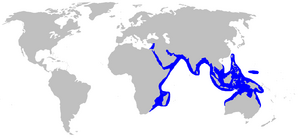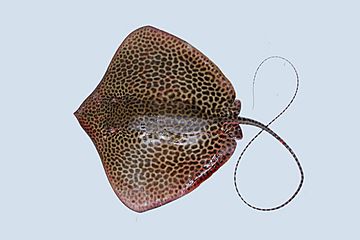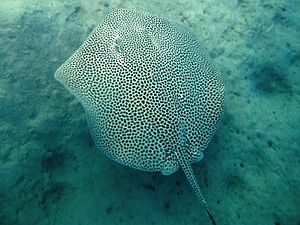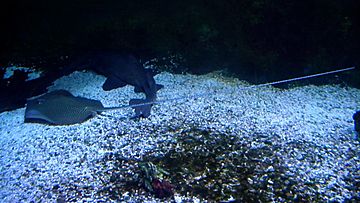Reticulate whipray facts for kids
Quick facts for kids Reticulate whipray |
|
|---|---|
 |
|
| Conservation status | |
| Scientific classification | |
| Genus: |
Himantura
|
| Species: |
uarnak
|
 |
|
| Range of the reticulate whipray | |
| Synonyms | |
The reticulate whipray or honeycomb stingray (Himantura uarnak) is a type of stingray. It belongs to the Dasyatidae family. These rays live in coastal and brackish waters. You can find them across the Indo-Pacific region. This area stretches from South Africa to Taiwan and Australia. They especially like sandy places.
This is a very large stingray. It can grow up to 2 m (6.6 ft) wide. It has a diamond-shaped body and a super long tail. Its tail does not have any fin folds. Both its common name and scientific name describe its look. They refer to the many small, dark spots on its back. These spots form a net-like pattern on a lighter background.
The reticulate whipray often rests on the bottom during the day. It hunts for bottom-dwelling creatures. These include invertebrates (animals without backbones) and bony fishes. Like other stingrays, it gives birth to live young. The babies grow inside the mother. They are first fed by yolk, then by a special "uterine milk."
Females can have up to five pups in the summer. Their pregnancy lasts about a year. People in Southeast Asia and the Indian Ocean fish for this ray. They use it for meat, skin, and other things. This species is easily harmed by overfishing. This is because of its large size and slow reproduction. Its habitat is also being damaged. The International Union for Conservation of Nature (IUCN) calls this species Vulnerable.
Contents
What is the Reticulate Whipray?
The reticulate whipray is a fascinating marine animal. It was first described by Peter Forsskål in 1775. He called a spotted version of another ray "uarnak." This is an Arabic word for stingrays. Later, scientists like Johann Friedrich Gmelin named it a separate species.
In 1837, scientists put this ray into a new group called Himantura. The reticulate whipray is very similar to other spotted rays. These include H. undulata and H. leoparda. Because they look so alike, it has been hard for scientists to tell them apart. They are still studying if different color patterns mean different species.
How to Identify a Reticulate Whipray
The reticulate whipray has a flat, diamond-shaped body. It is wider than it is long. Its front edges are mostly straight. Young rays have a rounder body shape. Their eyes are small, with breathing holes called spiracles right behind them.
It has a small mouth with little bumps inside. These bumps are called papillae. The tail is very long and thin, like a whip. It can be 3 to 3.5 times longer than its body. There is usually one stinging spine on the tail. This spine is located some distance from the body.
Adult rays have rough, heart-shaped scales called dermal denticles. These cover their back from between their eyes to the tail spine. They also have two large "pearl thorns" in the middle of their back. The tail behind the spine is also covered in small thorns.
The color of the reticulate whipray changes with age and where it lives. Adults usually have many dark brown spots. These spots form a net-like pattern on a light brown background. The underside of the ray is pale. Young rays are yellowish with tiny, dark spots. This ray can grow very large. It can reach 2 m (6.6 ft) wide and 6 m (20 ft) long. It can weigh up to 120 kg (260 lb).
Where Do Reticulate Whiprays Live?
The reticulate whipray lives across the Indo-Pacific region. Its home stretches from eastern South Africa to the Arabian Peninsula. It goes along the coast of India to Southeast Asia. You can find it as far north as Taiwan and the Ryukyu Islands. To the southeast, it reaches New Guinea and northern Australia.
It has also moved into the eastern Mediterranean Sea through the Suez Canal. This is called a Lessepsian migrant. It is now common there. This species seems most common in Australian waters.
These rays live on the bottom of the ocean. They are often found over sandy areas near beaches. They also live in lagoons and around coral reefs. They can be in very shallow water or as deep as 50 m (160 ft). They can handle water that is not very salty. They are known to enter estuaries and mangrove swamps. They prefer water temperatures between 23–26 °C (73–79 °F).
Life and Habits of the Reticulate Whipray
During the day, the reticulate whipray is usually quiet. It spends a lot of time resting on the sea floor. Sometimes, it buries itself in the sand. In Shark Bay, Australia, these rays rest alone or in small groups. They often do this in very shallow water during high tide.
Their lateral line system helps them sense danger. This system extends to the tip of their long tail. This gives them early warning of predators. Predators include bottlenose dolphins and hammerhead sharks. The cowtail stingray often rests with reticulate whiprays. This is because the whiprays' longer tails help them spot predators better. These mixed groups sometimes form a "rosette." Their tails point outwards to watch for danger.
The reticulate whipray eats many different bottom-dwelling animals. These include crabs, shrimps, bivalves, and bony fishes. In the western Indian Ocean, fish make up most of their diet. In Australia, they mainly eat prawns.
Reproduction and Life Cycle
Like other stingrays, the reticulate whipray gives birth to live young. This is called aplacental viviparous. The baby rays grow inside the mother. They first get food from a yolk sac. Later, the mother produces a special "uterine milk." This milk is rich in proteins and lipids.
Females give birth to up to five pups in the summer. The pregnancy lasts about a year. Off South Africa, newborn rays are about 28–30 cm (11–12 in) wide. They become adults when they are about 1 m (3.3 ft) wide. This happens when they are 4-5 years old. In Australia, newborns are 21–28 cm (8.3–11.0 in) wide. Young rays of this species look different from adults. They are also more distinct from other young stingrays than the adults are. Shark Bay might be a special place where young rays grow up.
Reticulate Whiprays and Humans
The reticulate whipray is a strong fighter when caught on a fishing line. This makes it popular with recreational anglers. These anglers usually release the ray alive. However, it is also caught by large-scale fishing in Southeast Asia and the Indian Ocean. Fishermen use nets and lines to catch them.
People use the ray's meat, skin, and cartilage. But it is not a highly valued food fish. It is also used in Chinese medicine. Its tail might be sold as a souvenir.
The International Union for Conservation of Nature (IUCN) lists the reticulate whipray as Vulnerable. This means it is at risk of disappearing. Its large size and slow reproduction make it easy to overfish. Also, its coastal home is being damaged. For example, many mangrove forests in Indonesia and Malaysia have been cut down. Pollution and harmful fishing methods also hurt these rays.
Australian waters offer some protection for the reticulate whipray. Here, it is not a main target for fishing. Special devices on fishing nets help reduce accidental catches. However, there are signs of illegal fishing by other countries in Australian waters.
Sometimes, reticulate whiprays are sold for home aquariums. But they are best avoided because they grow so big. They are also kept in some public aquariums. These include the Aquarium of the Pacific and the California Academy of Sciences' Steinhart Aquarium.
Images for kids
See also
 In Spanish: Himantura uarnak para niños
In Spanish: Himantura uarnak para niños












